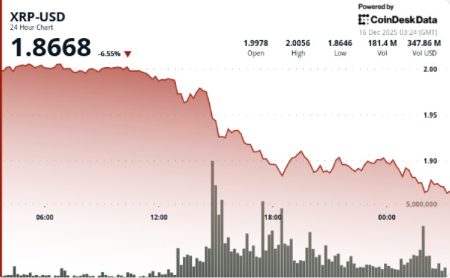Crypto Market Plunges: Beyond Trump’s China Tariffs, Revealing a Complex Web of Factors
Market Sentiment Shifts as Traders Seek Simple Explanations for Complex Downturn
In the aftermath of Friday’s significant cryptocurrency market decline, retail traders quickly pointed to U.S. President Donald Trump’s announcement of 100% tariffs on Chinese imports as the primary culprit. This immediate attribution reflects a common pattern among crypto investors seeking straightforward explanations for market volatility, according to blockchain analytics firm Santiment. However, market analysts suggest that the recent downturn stems from a more intricate combination of factors beyond just geopolitical tensions, revealing the complex nature of cryptocurrency market dynamics.
“This is typical ‘rationalization’ behavior from retailers, who need to point to a singular event as the reason for a cataclysmic downturn in crypto,” Santiment explained in their Saturday report. The firm noted how quickly social media conversations converged around U.S.-China tariff concerns following the market crash, with discussions spiking dramatically as participants collectively sought to make sense of the sudden price decline. This behavior highlights how retail investors often gravitate toward simple narratives during periods of market stress rather than examining the multifaceted forces at play.
Leverage Imbalance Magnified Market Reaction to Geopolitical Catalyst
While Trump’s tariff announcement certainly served as a catalyst for the market’s downward movement, analysts from The Kobeissi Letter emphasized that “excessive leverage and risk” in the cryptocurrency ecosystem significantly amplified the decline. Their analysis revealed a striking imbalance in market positioning, with approximately $16.7 billion in long positions liquidated compared to just $2.5 billion in shorts—a lopsided ratio of nearly 7-to-1. This heavy long bias created the conditions for a dramatic cascade of forced selling once prices began to fall, transforming what might have been a moderate correction into a substantial market event.
The magnitude of this liquidation cascade became evident as Bitcoin (BTC) shed more than 10% of its value within a 24-hour period. On Binance, the BTC/USDT futures pair plummeted to approximately $102,000 in the immediate aftermath of Trump’s announcement, highlighting how quickly leveraged positions can unwind when market sentiment shifts. This volatility underscores the cryptocurrency market’s continued susceptibility to rapid, leverage-driven price movements despite its growing maturity and institutional adoption over recent years.
Retail Sentiment’s Crucial Role in Short-term Market Direction
Santiment’s analysis suggests that ongoing developments in U.S.-China relations will play a pivotal role in shaping retail investors’ trading decisions in the near term. The firm noted that any improvement in diplomatic talks between President Trump and Chinese President Xi Jinping resulting in “positive news” could significantly boost retail sentiment toward cryptocurrencies. This potential sentiment shift highlights how geopolitical factors have become increasingly important for crypto markets, reflecting Bitcoin’s evolving correlation with traditional risk assets.
Conversely, Santiment warned that further deterioration in U.S.-China relations could trigger increasingly pessimistic price forecasts among market participants. “Expect for the ‘Bitcoin sub-100K’ prediction floodgates to begin opening up,” the firm cautioned, adding that “Bitcoin, whether we like it or not, is behaving more like a risk asset than a safe haven during times of country tensions.” This observation challenges the long-held narrative of Bitcoin as “digital gold” or a hedge against geopolitical instability, suggesting instead that the cryptocurrency currently trades more like growth-oriented risk assets during periods of international tension.
Fear Replaces Greed as Market Sentiment Indicator Hits Six-Month Low
The impact of the market decline on investor psychology was immediately apparent in sentiment metrics. The Crypto Fear & Greed Index, a widely-followed barometer of overall market sentiment, plunged to a “Fear” level of 27 in Saturday’s update. This represents a precipitous 37-point collapse from Friday’s “Greed” reading of 64, marking the index’s lowest level in nearly six months. Such a dramatic sentiment shift illustrates how quickly market psychology can transform during periods of heightened volatility, often creating conditions where emotional reactions drive further price movements.
At the time of publication, Bitcoin is trading at approximately $109,910, reflecting a 10.06% decline over the past seven days. This price action comes amid broader uncertainty about the cryptocurrency’s near-term trajectory as investors reassess their risk exposure in light of evolving geopolitical circumstances. As market participants digest these developments, the coming weeks may prove critical in determining whether the recent downturn represents a temporary correction within a longer-term uptrend or the beginning of a more sustained market adjustment. What remains clear is that cryptocurrency markets continue to demonstrate their sensitivity to a diverse array of factors beyond traditional fundamental analysis, making them both fascinating and challenging for investors to navigate.
The Evolution of Bitcoin’s Market Identity Amid Global Uncertainty
The current market dynamics highlight an important evolution in how Bitcoin is perceived and traded during periods of global uncertainty. While Bitcoin was initially conceptualized and often promoted as a decentralized alternative to traditional financial systems—theoretically insulated from geopolitical tensions—its actual trading patterns increasingly resemble those of conventional risk assets. This transformation raises important questions about Bitcoin’s long-term value proposition and its role in diversified investment portfolios.
Institutional investors, who have been steadily increasing their cryptocurrency exposure over recent years, may now need to recalibrate their risk models to account for Bitcoin’s apparent sensitivity to geopolitical developments. Meanwhile, retail traders will likely continue to monitor U.S.-China relations closely, with market sentiment potentially swinging dramatically based on diplomatic developments. As the cryptocurrency ecosystem matures further, understanding these evolving correlations and market behaviors will become increasingly crucial for investors seeking to navigate this dynamic asset class successfully. Whether Bitcoin eventually transitions toward behaving more like a true safe-haven asset or continues its current pattern of correlation with risk assets during times of global tension remains one of the most consequential questions facing cryptocurrency investors in the months and years ahead.













